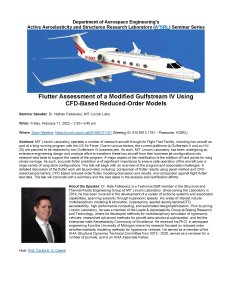Presented By: Aerospace Engineering
Department of Aerospace Engineering Seminar Series: Active Aeroelasticity and Structures Research Laboratory (A2SRL)

Speaker: Dr. Nathan Falkiewicz
MIT Lincoln Laboratory operates a number of research aircraft through its Flight Test Facility, including two aircraft as part of a long-running program with the US Air Force. Due to various factors, the current platforms (a Gulfstream II and an HU-25) are planned to be replaced by two Gulfstream IV business jets. As such, MIT Lincoln Laboratory has been undergoing an extensive engineering design and analysis effort to transform these two aircraft from their business jet configurations into research test beds to support the needs of the program. A major aspect of the modification is the addition of hard points for wing stores carriage. As such, accurate flutter prediction is of significant importance to ensure safe operation of the aircraft over a large variety of wing store configurations. The talk will begin with an overview of the program and associated challenges. A detailed discussion of the flutter work will be provided, including: comparison of flutter results using panel method and CFD- based aerodynamics, CFD-based reduced-order flutter modeling discussion and results, and comparison against flight flutter test data. The talk will conclude with a summary and the next steps in the analysis and certification efforts.
MIT Lincoln Laboratory operates a number of research aircraft through its Flight Test Facility, including two aircraft as part of a long-running program with the US Air Force. Due to various factors, the current platforms (a Gulfstream II and an HU-25) are planned to be replaced by two Gulfstream IV business jets. As such, MIT Lincoln Laboratory has been undergoing an extensive engineering design and analysis effort to transform these two aircraft from their business jet configurations into research test beds to support the needs of the program. A major aspect of the modification is the addition of hard points for wing stores carriage. As such, accurate flutter prediction is of significant importance to ensure safe operation of the aircraft over a large variety of wing store configurations. The talk will begin with an overview of the program and associated challenges. A detailed discussion of the flutter work will be provided, including: comparison of flutter results using panel method and CFD- based aerodynamics, CFD-based reduced-order flutter modeling discussion and results, and comparison against flight flutter test data. The talk will conclude with a summary and the next steps in the analysis and certification efforts.